Recent Advances in Sewer Biofilms: A Perspective on Bibliometric Analysis
Abstract
1. Introduction
2. Methodology
2.1. Data Sources
2.2. Research Methodology
3. Results and Discussion
3.1. Annual Distribution of Literature
3.2. Source Distribution of Literature
3.3. Cooperation Analysis
3.3.1. Collaborative Network Analysis of Countries
3.3.2. Collaborative Network Analysis of Institutions
3.3.3. Co-Authorship Analysis
3.4. Co-Citation Analysis
3.4.1. Author Co-Citation Analysis
3.4.2. Document Co-Citation Analysis
3.5. Co-Word Analysis
3.5.1. Keywords Co-Occurrence Analysis
3.5.2. Keywords Clustering Analysis
3.5.3. Keywords Evolution Analysis
4. Conclusions
Author Contributions
Funding
Data Availability Statement
Conflicts of Interest
References
- Henrici, A.T. Studies of freshwater bacteria I A direct microscopic technique. J. Bacteriol. 1933, 25, 277–287. [Google Scholar] [CrossRef] [PubMed]
- Flemming, H.-C.; Wingender, J. The biofilm matrix. Nat. Rev. Microbiol. 2010, 8, 623–633. [Google Scholar] [CrossRef]
- Penesyan, A.; Paulsen, I.T.; Kjelleberg, S.; Gillings, M.R. Three faces of biofilms: A microbial lifestyle, a nascent multicellular organism, and an incubator for diversity. NPJ Biofilms Microbiomes 2021, 7, 80. [Google Scholar] [CrossRef]
- Chen, Y.; Wu, J.; Zhao, J.; Yang, H.; Attaran Dovom, H.; Sivakumar, M.; Jiang, G. A critical review of sulfide and methane control in urban sewer systems using nitrogen compounds. Water Res. 2025, 277, 123314. [Google Scholar] [CrossRef] [PubMed]
- Cen, X.; Li, J.; Jiang, G.; Zheng, M. A critical review of chemical uses in urban sewer systems. Water Res. 2023, 240, 120108. [Google Scholar] [CrossRef]
- Gao, Y.; Shi, X.; Jin, X.; Wang, X.C.; Jin, P. A critical review of wastewater quality variation and in-sewer processes during conveyance in sewer systems. Water Res. 2023, 228, 119398. [Google Scholar] [CrossRef] [PubMed]
- Gasperi, J.; Gromaire, M.C.; Kafi, M.; Moilleron, R.; Chebbo, G. Contributions of wastewater, runoff and sewer deposit erosion to wet weather pollutant loads in combined sewer systems. Water Res. 2010, 44, 5875–5886. [Google Scholar] [CrossRef]
- Rodenburg, L.A.; Du, S.; Fennell, D.E.; Cavallo, G.J. Evidence for Widespread Dechlorination of Polychlorinated Biphenyls in Groundwater, Landfills, and Wastewater Collection Systems. Environ. Sci. Technol. 2010, 44, 7534–7540. [Google Scholar] [CrossRef]
- Ren, B.; Shi, X.; Jin, X.; Wang, X.C.; Jin, P. Comprehensive evaluation of pharmaceuticals and personal care products (PPCPs) in urban sewers: Degradation, intermediate products and environmental risk. Chem. Eng. J. 2021, 404, 127024. [Google Scholar] [CrossRef]
- Shi, X.; Ren, B.; Jin, X.; Wang, X.C.; Jin, P. Metabolic hazards of pharmaceuticals and personal care products (PPCPs) in sewers. J. Hazard. Mater. 2022, 432, 128539. [Google Scholar] [CrossRef]
- McCall, A.-K.; Bade, R.; Kinyua, J.; Lai, F.Y.; Thai, P.K.; Covaci, A.; Bijlsma, L.; van Nuijs, A.L.N.; Ort, C. Critical review on the stability of illicit drugs in sewers and wastewater samples. Water Res. 2016, 88, 933–947. [Google Scholar] [CrossRef]
- Xu, Z.; Wu, J.; Li, H.; Chen, Y.; Xu, J.; Xiong, L.; Zhang, J. Characterizing heavy metals in combined sewer overflows and its influence on microbial diversity. Sci. Total Environ. 2018, 625, 1272–1282. [Google Scholar] [CrossRef] [PubMed]
- Liu, S.; Guo, H.; Wang, Y.; Hou, J.; Zhu, T.; Liu, Y. Peracetic acid activated by ferrous ion mitigates sulfide and methane production in rising main sewers. Water Res. 2023, 245, 120584. [Google Scholar] [CrossRef] [PubMed]
- Zhang, J.; Chen, Z.; Liu, Y.; Wei, W.; Ni, B.J. Iron-assisted bio-chemical processes in sewer systems: Iron cycle and its role in sewer management. J. Clean. Prod. 2023, 414, 137707. [Google Scholar] [CrossRef]
- Li, Y.; He, Y.; Guo, H.; Hou, J.; Dai, S.; Zhang, P.; Tong, Y.; Ni, B.J.; Zhu, T.; Liu, Y. Sulfur-containing substances in sewers: Transformation, transportation, and remediation. J. Hazard. Mater. 2024, 467, 133618. [Google Scholar] [CrossRef]
- Shi, X.; Liu, W.; Xu, D.; Hou, Y.; Ren, B.; Jin, X.; Wang, X.C.; Jin, P. Metagenomics analysis of ecosystem integrating methane and sulfide generation in urban sewer systems. J. Clean. Prod. 2023, 382, 135372. [Google Scholar] [CrossRef]
- Guo, H.; Dai, S.; Li, Y.; Wang, H.; Hou, J.; He, Y.; Wang, Y.; Zhu, T.; Sun, P.; Ni, B.-J.; et al. Enhancing sulfide and methane control in sewers: Unveiling the impact and mechanisms of free nitrous acid pre-exposure coupled with calcium peroxide dosing. Chem. Eng. J. 2024, 495, 153576. [Google Scholar] [CrossRef]
- Ai, T.; He, Q.; Xu, J.; Yin, F.; Li, H.; Ai, H. A conceptual method to simultaneously inhibit methane and hydrogen sulfide production in sewers: The carbon metabolic pathway and microbial community shift. J. Environ. Manag. 2019, 246, 119–127. [Google Scholar] [CrossRef]
- Zuo, Z.; Xing, Y.; Liu, T.; Zheng, M.; Lu, X.; Chen, Y.; Jiang, G.; Liang, P.; Huang, X.; Liu, Y. Methane mitigation via the nitrite-DAMO process induced by nitrate dosing in sewers. Water Res. 2024, 257, 121701. [Google Scholar] [CrossRef]
- Guo, H.; Liu, S.; Wang, Y.; Wang, Y.; Hou, J.; Zhu, T.; Liu, Y. Reduced sulfide and methane in rising main sewer via calcium peroxide dosing: Insights from microbial physiological characteristics, metabolisms and community traits. J. Hazard. Mater. 2023, 451, 131138. [Google Scholar] [CrossRef]
- Shi, X.; Ngo, H.H.; Sang, L.; Jin, P.; Wang, X.C.; Wang, G. Functional evaluation of pollutant transformation in sediment from combined sewer system. Environ. Pollut. 2018, 238, 85–93. [Google Scholar] [CrossRef]
- Mugani, R.; El Khalloufi, F.; Redouane, E.M.; Haida, M.; Aba, R.P.; Essadki, Y.; El Amrani Zerrifi, S.; Hejjaj, A.; Ouazzani, N.; Campos, A.; et al. Unlocking the potential of bacterioplankton-mediated microcystin degradation and removal: A bibliometric analysis of sustainable water treatment strategies. Water Res. 2024, 255, 121497. [Google Scholar] [CrossRef] [PubMed]
- Lan, Y.; Gao, X.; Xu, H.; Li, M. 20 years of polybrominated diphenyl ethers on toxicity assessments. Water Res. 2024, 249, 121007. [Google Scholar] [CrossRef] [PubMed]
- Du, C.; Li, Z. Bibliometric analysis and systematic review of fluoride-containing wastewater treatment: Development, hotspots and future perspectives. J. Environ. Manag. 2024, 370, 122564. [Google Scholar] [CrossRef] [PubMed]
- Chen, C. CiteSpace II: Detecting and visualizing emerging trends and transient patterns in scientific literature. J. Am. Soc. Inf. Sci. Technol. 2006, 57, 359–377. [Google Scholar] [CrossRef]
- Chen, C. Searching for intellectual turning points: Progressive knowledge domain visualization. Proc. Natl. Acad. Sci. USA 2004, 101, 5303–5310. [Google Scholar] [CrossRef]
- Liu, N.; Gao, R.; Xiao, S.; Xue, B. Visualizing the bibliometrics of biochar research for remediation of arsenic pollution. J. Environ. Manag. 2024, 349, 119513. [Google Scholar] [CrossRef]
- Nielsen, P.H. Biofilm Dynamics and Kinetics during High-Rate Sulfate Reduction under Anaerobic Conditions. Appl. Environ. Microbiol. 1987, 53, 27–32. [Google Scholar] [CrossRef]
- Ito, T.; Nielsen, J.L.; Okabe, S.; Watanabe, Y.; Nielsen, P.H. Phylogenetic Identification and Substrate Uptake Patterns of Sulfate-Reducing Bacteria Inhabiting an Oxic-Anoxic Sewer Biofilm Determined by Combining Microautoradiography and Fluorescent In Situ Hybridization. Appl. Environ. Microbiol. 2002, 68, 356–364. [Google Scholar] [CrossRef]
- Lv, J.-Q.; Yin, W.-X.; Xu, J.-M.; Cheng, H.-Y.; Li, Z.-L.; Yang, J.-X.; Wang, A.-J.; Wang, H.-C. Augmented machine learning for sewage quality assessment with limited data. Environ. Sci. Ecotechnol. 2025, 23, 100512. [Google Scholar] [CrossRef]
- Jiang, Y.; Li, C.; Sun, L.; Guo, D.; Zhang, Y.; Wang, W. A deep learning algorithm for multi-source data fusion to predict water quality of urban sewer networks. J. Clean. Prod. 2021, 318, 128533. [Google Scholar] [CrossRef]
- Jiang, Y.; Li, C.; Zhang, Y.; Zhao, R.; Yan, K.; Wang, W. Data-driven method based on deep learning algorithm for detecting fat, oil, and grease (FOG) of sewer networks in urban commercial areas. Water Res. 2021, 207, 117797. [Google Scholar] [CrossRef] [PubMed]
- Lu, J.; Zhao, H.; Zhang, Z.; Jin, F.; Pang, H.; Yang, J.; Wang, X.; Chen, R. Control of chemical and microbial pollutants in liquid-solid phases of sewer pipes by Fe(II)-activated persulfate: Performance and mechanism of simultaneous removal. Chem. Eng. J. 2023, 468, 143486. [Google Scholar] [CrossRef]
- Zhang, Z.; Ren, X.; Liu, Y.; Song, S.; Ren, Y.; Li, L.; Pang, H.; Yang, J.; Lu, J. Enhancing sulfide mitigation via the synergistic dosing of calcium peroxide and ferrous ions in gravity sewers: Efficiency and mechanism. J. Hazard. Mater. 2025, 487, 137285. [Google Scholar] [CrossRef]
- Zhang, Z.; Chen, W.; Liu, D.; Li, L.; Liu, B.; Pang, H.; Zhang, Z.; Lu, J. Enhancing sewer low-loss transportation by selective capture of green quaternized chitosan aerogel beads: Ordinal mechanism of pore formation and adsorption-antibacteria. J. Water Process Eng. 2025, 69, 106816. [Google Scholar] [CrossRef]
- Zhang, Z.; Chang, N.; Wang, S.; Lu, J.; Li, K.; Zheng, C. Enhancing sulfide mitigation via the sustainable supply of oxygen from air-nanobubbles in gravity sewers. Sci. Total Environ. 2022, 808, 152203. [Google Scholar] [CrossRef]
- Li, J.; Gao, J.; Thai, P.K.; Sun, X.; Mueller, J.F.; Yuan, Z.; Jiang, G. Stability of Illicit Drugs as Biomarkers in Sewers: From Lab to Reality. Environ. Sci. Technol. 2018, 52, 1561–1570. [Google Scholar] [CrossRef]
- Cao, J.; Zhang, L.; Hong, J.; Sun, J.; Jiang, F. Different ferric dosing strategies could result in different control mechanisms of sulfide and methane production in sediments of gravity sewers. Water Res. 2019, 164, 114914. [Google Scholar] [CrossRef]
- Jin, P.; Shi, X.; Sun, G.; Yang, L.; Cai, Y.; Wang, X.C. Co-Variation between Distribution of Microbial Communities and Biological Metabolization of Organics in Urban Sewer Systems. Environ. Sci. Technol. 2018, 52, 1270–1279. [Google Scholar] [CrossRef]
- Hvitved-Jacobsen, T.; Vollertsen, J.; Nielsen, A.H. Sewer Processes: Microbial and Chemical Process Engineering of Sewer Networks, 2nd ed.; CRC Press: Boca Raton, FL, USA, 2013. [Google Scholar]
- Li, W.; Zheng, T.; Ma, Y.; Liu, J. Current status and future prospects of sewer biofilms: Their structure, influencing factors, and substance transformations. Sci. Total Environ. 2019, 695, 133815. [Google Scholar] [CrossRef]
- Tang, H.; Huang, S.; Zhang, C.; Shi, W. Advancements and challenges in reaping dual benefits of ultrafiltration technology: Fouling mitigation and emerging contaminants elimination. J. Clean. Prod. J. 2025, 486, 144584. [Google Scholar] [CrossRef]
- Jiang, G.; Keller, J.; Bond, P.L.; Yuan, Z. Predicting concrete corrosion of sewers using artificial neural network. Water Res. 2016, 92, 52–60. [Google Scholar] [CrossRef]
- Wang, X.; Li, L.; Bai, S.; Yuan, Z.; Miao, J.; Wang, M.; Ren, N. Comparative life cycle assessment of sewer corrosion control by iron salts: Suitability analysis and strategy optimization. Water Res. 2021, 201, 117370. [Google Scholar] [CrossRef] [PubMed]
- Pramanik, S.K.; Bhuiyan, M.; Robert, D.; Roychand, R.; Gao, L.; Cole, I.; Pramanik, B.K. Bio-corrosion in concrete sewer systems: Mechanisms and mitigation strategies. Sci. Total Environ. 2024, 921, 171231. [Google Scholar] [CrossRef]
- Hewayde, E.; Nehdi, M.; Allouche, E.; Nakhla, G. Effect of mixture design parameters and wetting-drying cycles on resistance of concrete to sulfuric acid attack. J. Mater. Civ. Eng. 2007, 19, 155–163. [Google Scholar] [CrossRef]
- Yusuf, H.H.; Roddick, F.; Jegatheesan, V.; Gao, L.; Pramanik, B.K. Tackling fat, oil, and grease (FOG) build-up in sewers: Insights into deposit formation and sustainable in-sewer management techniques. Sci. Total Environ. 2023, 904, 166761. [Google Scholar] [CrossRef] [PubMed]
- Wang, T.; Wu, K.; Kan, L.; Wu, M. Current understanding on microbiologically induced corrosion of concrete in sewer structures: A review of the evaluation methods and mitigation measures. Constr. Build. Mater. 2020, 247, 118539. [Google Scholar] [CrossRef]
- Zhang, L.; Qiu, Y.-Y.; Sharma, K.R.; Shi, T.; Song, Y.; Sun, J.; Liang, Z.; Yuan, Z.; Jiang, F. Hydrogen sulfide control in sewer systems: A critical review of recent progress. Water Res. 2023, 240, 120046. [Google Scholar] [CrossRef]
- Cen, X.; Hu, Z.; Yu, Z.; Huang, X.; Zuo, Z.; Guo, J.; Yuan, Z.; Zheng, M. Integrated application of nanoscale zero-valent iron for sulfide and methane control in sewers and improved wastewater treatment. Water Res. 2025, 276, 123248. [Google Scholar] [CrossRef]
- Tang, Z.; Xu, H.; Zhu, R.; Li, D.; Zhao, Z.; Xiao, H.; Li, H. Long-term effects of food waste on erosion resistance and production of methane and sulfide in sewer sediments: New insights into extracellular polymeric substances and genetic response mechanisms. J. Environ. Manag. 2025, 377, 124700. [Google Scholar] [CrossRef]


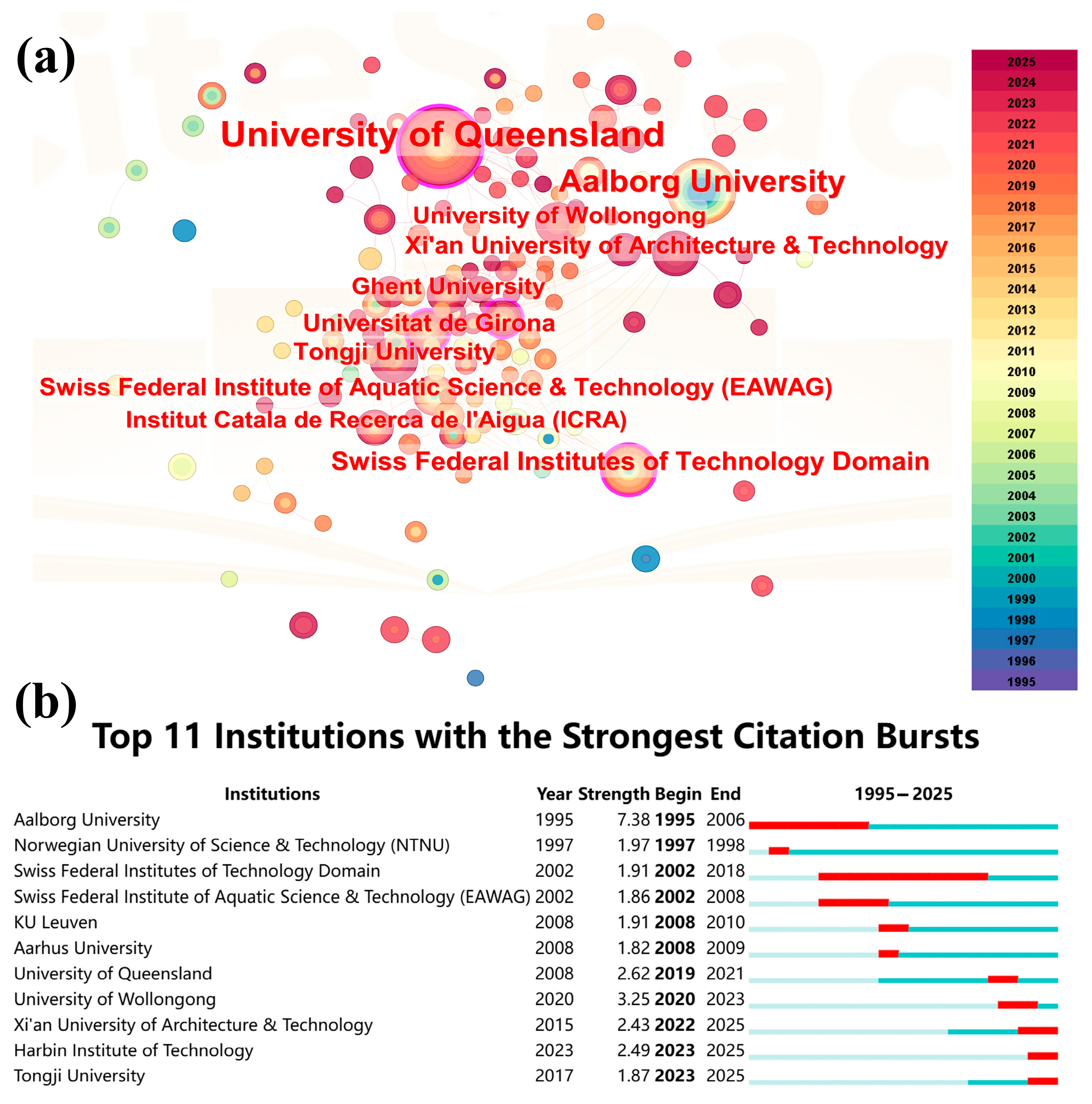
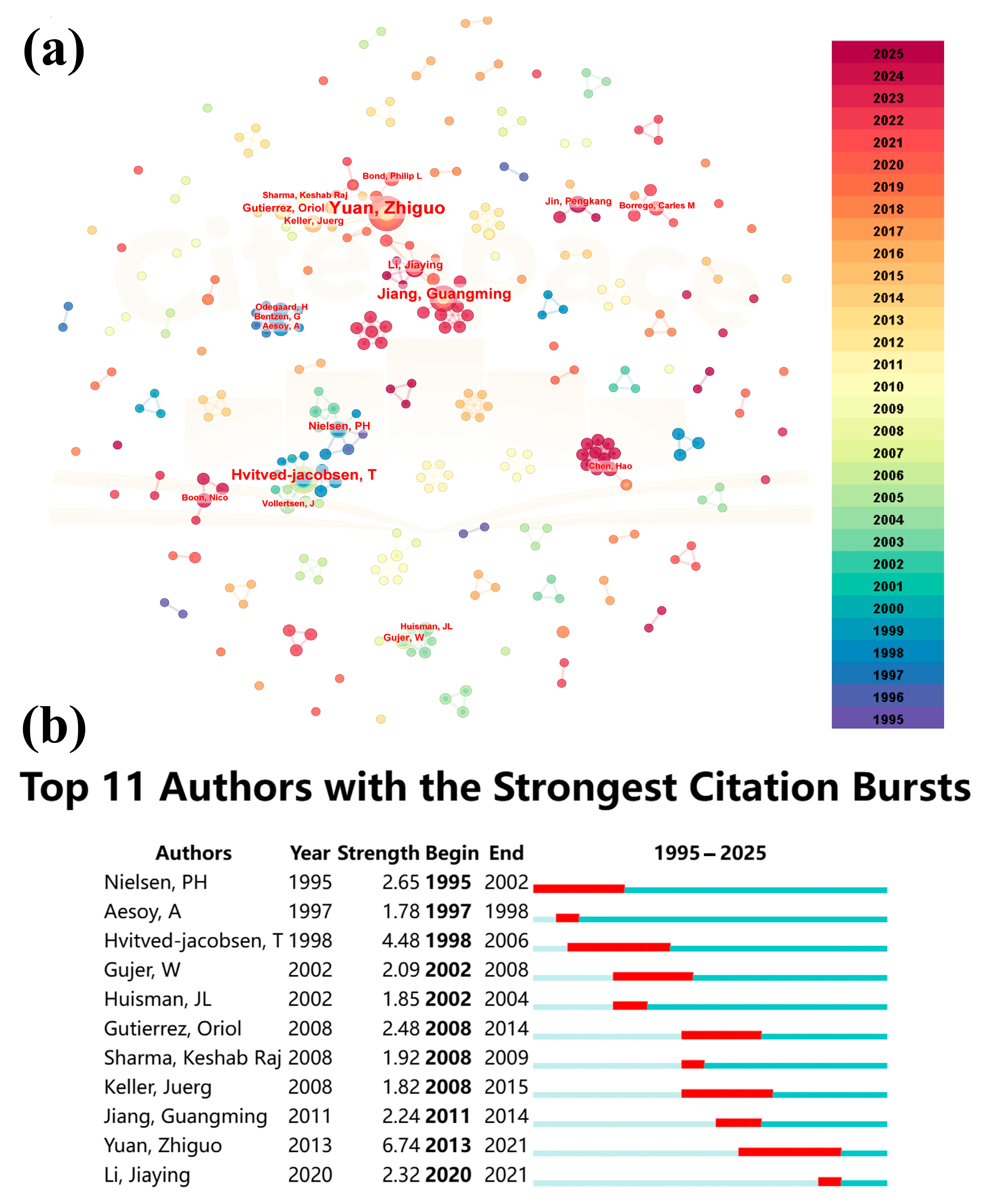
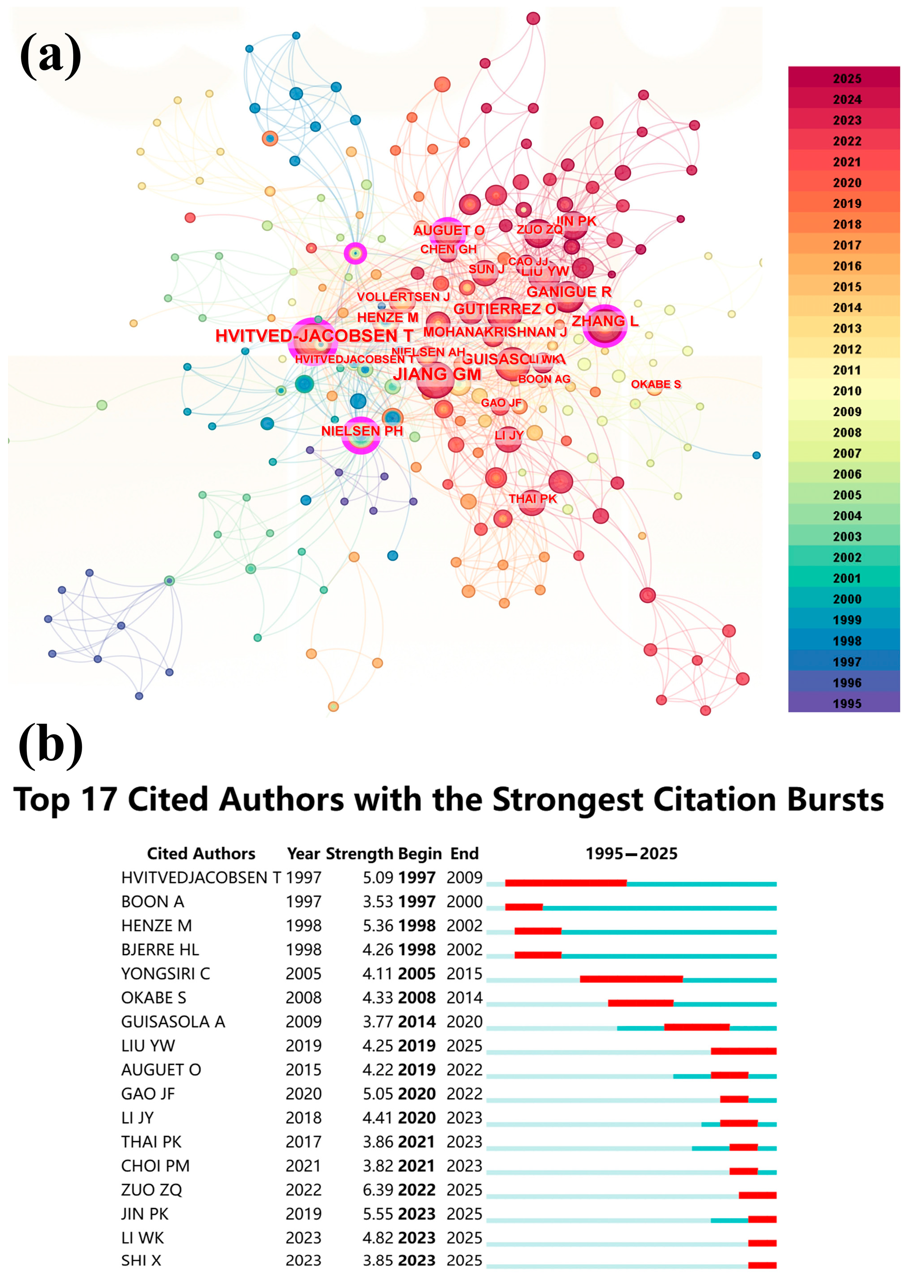

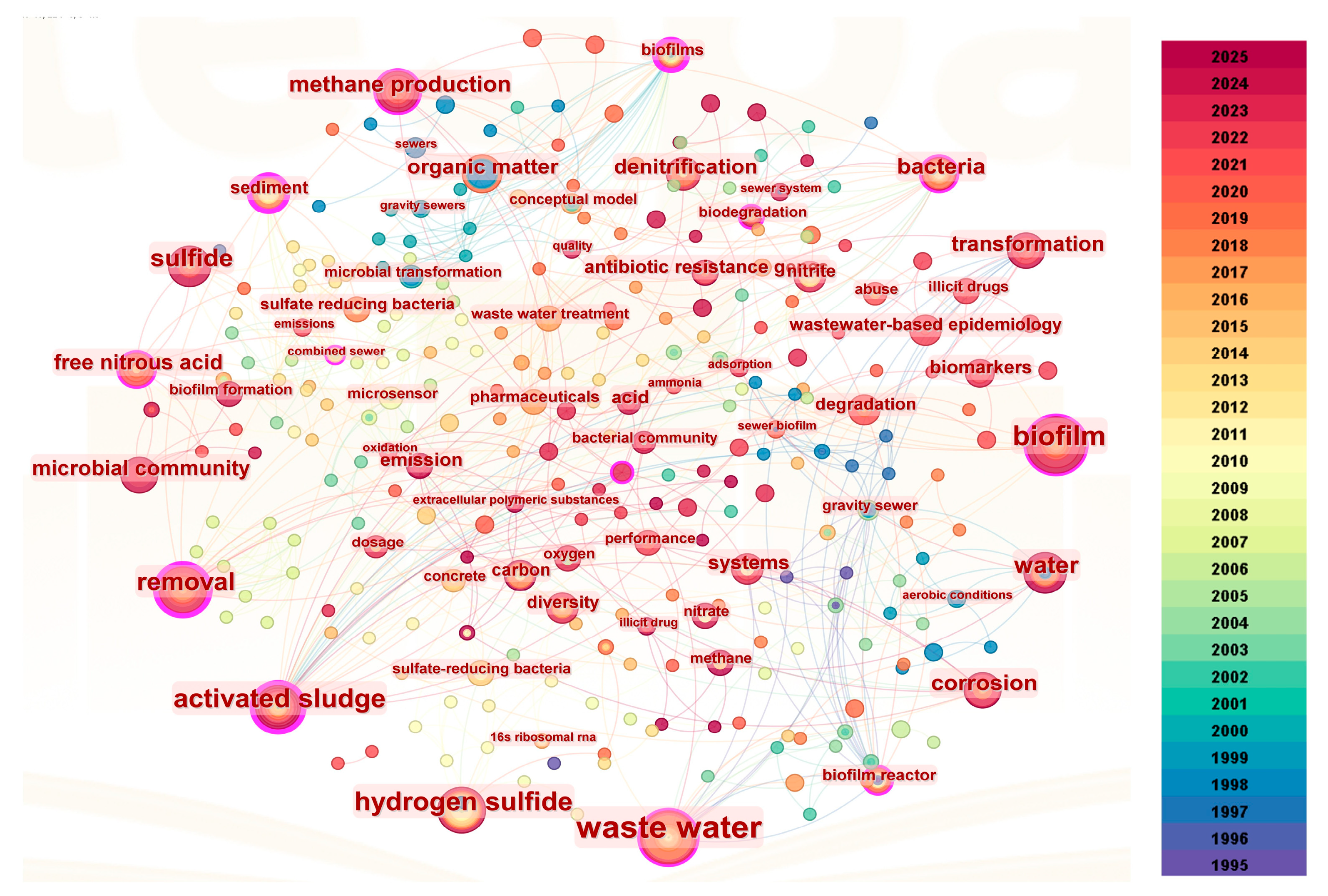
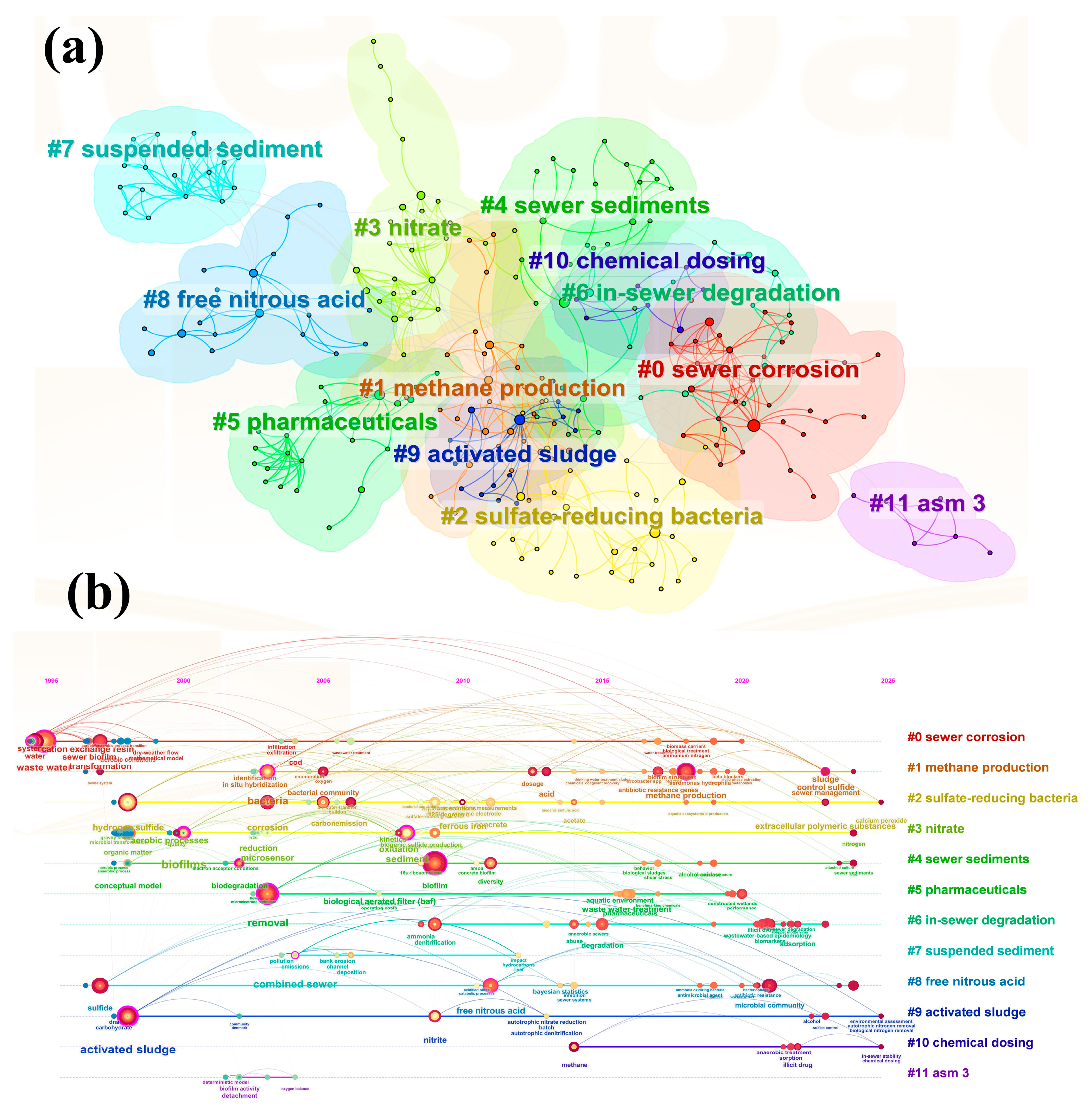
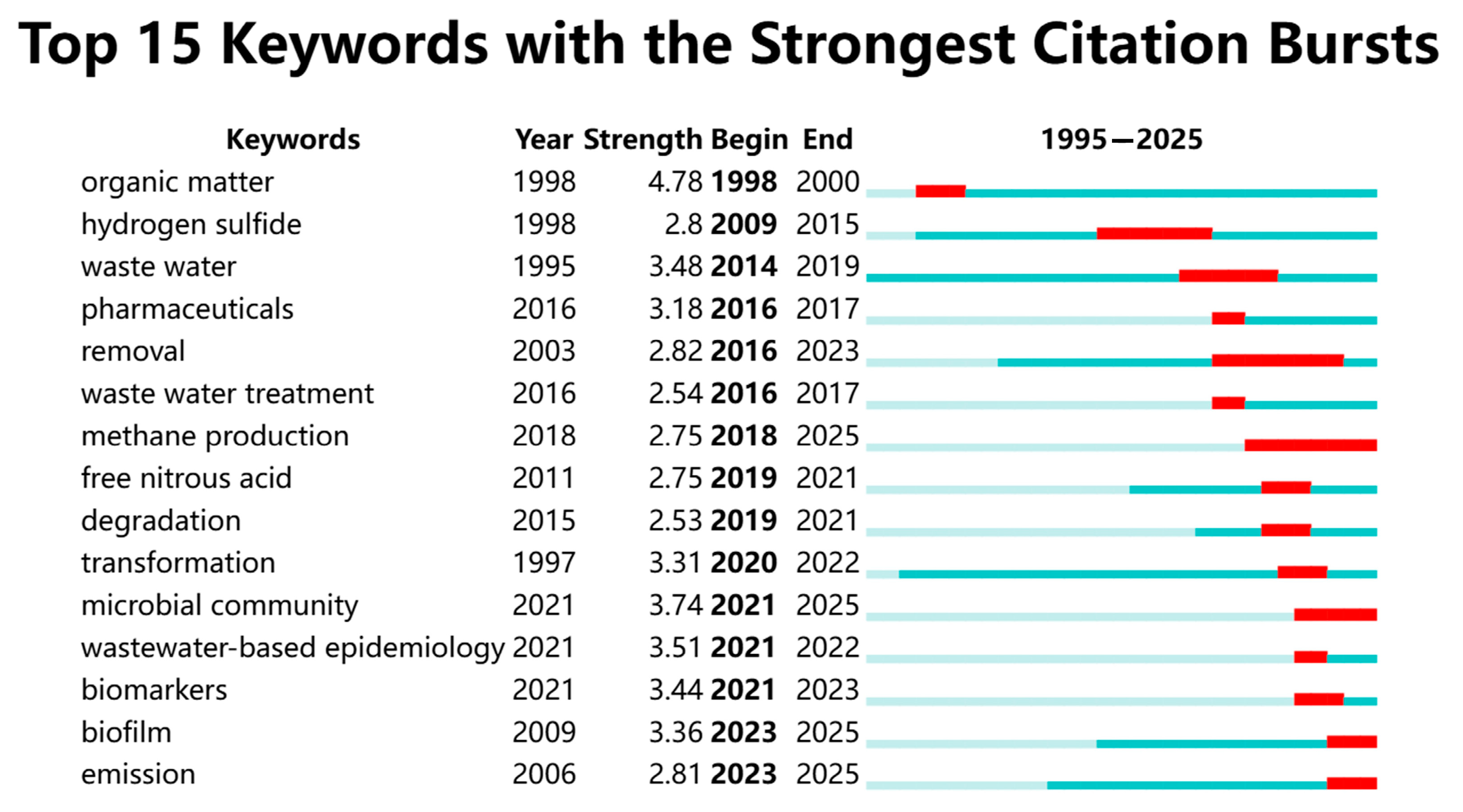
| No. | Source | Publications | Citations | Average Citation | IF (2023) |
|---|---|---|---|---|---|
| 1 | Water Research | 38 | 2159 | 56.82 | 11.5 |
| 2 | Water Science and Technology | 38 | 932 | 24.53 | 2.3 |
| 3 | Science of the Total Environment | 27 | 1114 | 41.26 | 8.2 |
| 4 | Journal of Hazardous Materials | 7 | 120 | 17.14 | 12.2 |
| 5 | Environmental Science Technology | 6 | 229 | 38.17 | 10.9 |
| 6 | Chemical Engineering Journal | 5 | 94 | 18.80 | 13.4 |
| 7 | Water Environment Research | 4 | 80 | 20.00 | 2.5 |
| 8 | Applied And Environmental Microbiology | 3 | 178 | 59.33 | 3.9 |
| 9 | Environment International | 3 | 98 | 32.67 | 10.3 |
| 10 | Water Air and Soil Pollution | 3 | 33 | 11 | 3.8 |
| 11 | Biochemical Engineering Journal | 3 | 29 | 9.67 | 3.7 |
| 12 | Environmental Pollution | 3 | 24 | 8 | 7.6 |
| 13 | Journal of Environmental Engineering | 3 | 18 | 6 | 1.6 |
| 14 | Environmental Technology | 3 | 12 | 4 | 2.2 |
| 15 | npj Clean Water | 3 | 2 | 0.67 | 10.5 |
| No. | Authors | Number of Publications | Centrality |
|---|---|---|---|
| 1 | Yuan, Zhiguo | 18 | 0.02 |
| 2 | Hvitved-Jacobsen, T | 11 | 0.01 |
| 3 | Jiang, Guangming | 11 | 0.01 |
| 4 | Gutierrez, Oriol | 5 | 0.00 |
| 5 | Li, Jiaying | 5 | 0.01 |
| 6 | Nielsen, PH | 5 | 0.00 |
| No. | Frequency | Centrality | Bursting Strength |
|---|---|---|---|
| 1 | HVITVED-JACOBSEN T. (52) | HVITVED-JACOBSEN T. (0.30) | Zuo Z.Q. (6.39) |
| 2 | JIANG G.M. (47) | NIELSEN P.H. (0.25) | JIN P.K. (5.55) |
| 3 | GUTIERREZ O. (31) | AUGUET O. (0.12) | HENZE M. (5.36) |
| 4 | ZHANG L. (29) | AESOY A. (0.12) | HVITVED-JACOBSEN T. (5.09) |
| 5 | GUISASOLA A. (28) | ZHANG L. (0.1) | GAO J.F. (5.05) |
| 6 | GANIGUE R. (24) | CAO Y.S. (0.1) | LI W.K. (4.82) |
| 7 | MOHANAKRISHNAN J. (21) | GANIGUE R. (0.09) | LI J.Y. (4.41) |
| 8 | NIELSEN P.H. (21) | HENZE M. (0.09) | OKABE S. (4.33) |
| 9 | LIU Y.W. (19) | JIANG G.M. (0.08) | BJERRE H.L. (4.26) |
| 10 | HENZE M. (19) | LI J.Y. (0.08) | LIU Y.W. (4.25) |
| 11 | AUGUET O. (19) | JIN P.K. (0.07) | AUGUET O. (4.22) |
| 12 | JIN P.K. (18) | BOON A.G. (0.07) | YONGSIRI C. (4.11) |
| 13 | ZUO Z.Q. (16) | ALMEIDA M.C. (0.07) | THAI P.K. (3.86) |
| 14 | VOLLERTSEN J. (16) | AHMED W. (0.06) | SHI X. (3.85) |
| 15 | LI J.Y. (16) | MOHANAKRISHNAN J. (0.05) | CHOI P.M. (3.82) |
| No. | Title | Journal | Frequency | Year | Reference |
|---|---|---|---|---|---|
| 1 | Stability of Illicit Drugs as Biomarkers in Sewers: From Lab to Reality | Environmental Science & Technology | 10 | 2018 | [37] |
| 2 | Sewer Processes—Microbial and Chemical Process Engineering of Sewer Networks | Boca Raton (Book) | 10 | 2013 | [40] |
| 3 | Different ferric dosing strategies could result in different control mechanisms of sulfide and methane production in sediments of gravity sewers | Water Research | 10 | 2019 | [38] |
| 4 | Co-Variation between Distribution of Microbial Communities and Biological Metabolization of Organics in Urban Sewer Systems | Environmental Science & Technology | 9 | 2018 | [39] |
| 5 | Current status and future prospects of sewer biofilms: Their structure, influencing factors, and substance transformations | Science of Total Environment | 9 | 2019 | [41] |
Disclaimer/Publisher’s Note: The statements, opinions and data contained in all publications are solely those of the individual author(s) and contributor(s) and not of MDPI and/or the editor(s). MDPI and/or the editor(s) disclaim responsibility for any injury to people or property resulting from any ideas, methods, instructions or products referred to in the content. |
© 2025 by the authors. Licensee MDPI, Basel, Switzerland. This article is an open access article distributed under the terms and conditions of the Creative Commons Attribution (CC BY) license (https://creativecommons.org/licenses/by/4.0/).
Share and Cite
Zhang, L.; Liu, J.; Song, G.; Huang, S.; Li, C.; Sunarso, J. Recent Advances in Sewer Biofilms: A Perspective on Bibliometric Analysis. Water 2025, 17, 3319. https://doi.org/10.3390/w17223319
Zhang L, Liu J, Song G, Huang S, Li C, Sunarso J. Recent Advances in Sewer Biofilms: A Perspective on Bibliometric Analysis. Water. 2025; 17(22):3319. https://doi.org/10.3390/w17223319
Chicago/Turabian StyleZhang, Linjun, Jinbiao Liu, Guoqiang Song, Shuchang Huang, Claudia Li, and Jaka Sunarso. 2025. "Recent Advances in Sewer Biofilms: A Perspective on Bibliometric Analysis" Water 17, no. 22: 3319. https://doi.org/10.3390/w17223319
APA StyleZhang, L., Liu, J., Song, G., Huang, S., Li, C., & Sunarso, J. (2025). Recent Advances in Sewer Biofilms: A Perspective on Bibliometric Analysis. Water, 17(22), 3319. https://doi.org/10.3390/w17223319








